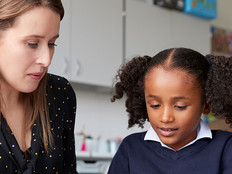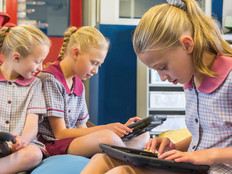Bridging Cultural and Educational Divides Through Distance Learning
Schools bridge cultural and educational divides through distance learning.
Not long ago, in a Bradenton, Fla., classroom, students sang “dona nobis pacem,” a Latin phrase meaning “give us peace.” Halfway around the world, children in Tanzania joined in with the Swahili version, “amani utupe,” while students in Guilin, China, sang the Mandarin counterpart, “gei women de hépÃng.”
Schools bridge cultural and educational divides through distance learning.
Not long ago, in a Bradenton, Fla., classroom, students sang “dona nobis pacem,” a Latin phrase meaning “give us peace.” Halfway around the world, children in Tanzania joined in with the Swahili version, “amani utupe,” while students in Guilin, China, sang the Mandarin counterpart, “gei women de hépÃng.”
And then technical difficulties disrupted the group singalong when the Skype connection slowed and the video froze. “Mixed results on that,” acknowledges Preston Boyd, who coordinates the Atlas Initiative program at Saint Stephen's Episcopal School in Bradenton. But that's OK, he says, because the exercise still lived up to the program's aim: to foster new ways of teaching and learning to help students become ecologically, economically and socially responsible citizens.
Despite the glitch, the teachers in all three classrooms were enthusiastic. They could see the potential in what was taking place. Not only were students learning curriculum material, they were collaborating in a global society – an increasingly critical skill.
“It's those kinds of moments where you just say, ‘Oh, my gosh!' We can create peace in this world by giving these kids ways to celebrate their differences and their similarities,” says Head of School Janet S. Pullen, who last year traveled to Tanzania to bring equipment – computer parts, pens, paper and markers – to Saint Stephen's partner schools. “It's the way of teaching in the 21st century.”
Travel Agents
What's happening at Saint Stephen's is hardly an anomaly. Thanks to readily available websites, software and equipment that span thousands of miles within seconds, distance learning is becoming increasingly common in schools around the world. “Just about every school is looking into it,” says Kathy Mickey, a senior analyst and managing editor of Simba Information's education group.
Most are turning to distance learning to expand course offerings locally, but international collaboration, she says, is a phenomenal application of the concept. “If you're working on a social studies project and can connect with people in different countries, why not?” she asks. “It makes perfect sense.”
And it's not as daunting as it may seem. “It's OK to start small and take baby steps,” says David Snodgress, director of technology and media services at Saint Stephen's. Six years ago, he burned disks containing Internet simulations for schools in Tanzania that didn't have web access – or reliable power grid electricity, for that matter (their computers operate on solar power).
Two years later, when the Lugalo Secondary School in Iringa, Tanzania, received web access, Pullen and her colleagues brought a brand-new Logitech Webcam Pro 9000 camera to Lugalo so the two schools could video conference via Skype. Not only did Saint Stephen's officials donate the equipment, they taught the teachers how to use the technology. “We don't just give them a box,” Pullen says. “We give them a box and training.”
Saint Stephen's intends to take the collaboration even further. Snodgress says the IT staff is currently looking at technologies that offer greater flexibility during the school's web conferencing broadcasts. They also plan to build a password-protected virtual school online where teachers can post videos of lectures at Saint Stephen's and lessons taught during the distance-learning video conference sessions.
Lugalo and Saint Stephen's have added a third partner – the Guilin DeZhi Foreign Language School in China – and Saint Stephen's connects weekly with each of these schools via webcam. During one video conference, Boyd asked students to put words to raw story plots such as “young prince loses father.” He then explained that the description summarizes the plot of Shakespeare's Hamlet. A teacher in China guided the same students through the plot of the film Mulan during another lesson.
Thanks to technology, students are interacting and collaborating in ways that didn't seem possible only a few years ago. “We've even dissected fetal pigs via video conference,” Pullen says. For that lesson, she adds, “they experienced everything but the smell.”
Global Warming
Claudine Curry recalls fondly her first experience with someone from another country. Through her eighth-grade Spanish class, she had a pen pal in Spain. In one letter she mentioned that her uncle is Sugar Minott, a famous reggae singer. As it turned out, Minott was her pen pal's favorite musician.
“That was such an eye-opening experience to me, as a 13-year-old, to see how the world is connected that way,” she says. Now an English as a Second Language kindergarten teacher at Bolton Academy Elementary School in Atlanta, Curry facilitates similar outreach opportunities for her students. During the 2008–2009 school year, she registered her class with ePals, an online global learning community, and connected with a school in Spain. Before long, she was connecting with classrooms around the world.
Her principal and the head of Bolton's International Baccalaureate program were so impressed by the collaborations that Curry's students were having with the foreign students that they asked her to register the entire school. Through ePals, Bolton's pre-K through fifth-grade students now connect with classrooms and families in Australia, Chile, France, Hong Kong, India, Kenya, Lithuania, Spain, Syria, Turkey, the United Arab Emirates and the United Kingdom.
“These little 5-year-old students are so globally minded. Maybe they won't get to travel,” Curry says of her students, 90 percent of whom live below the poverty line, “but through ePals, they can video conference, e-mail and collaborate with students from all over the world.”
Debra Caven has seen a similar difference in her students' worldviews and behaviors. In her class at Lake Shore Middle School in Mequon, Wis., sixth-graders e-mail via ePals and use Moodle to work together on projects about global warming, habitats and maps. This year, they started a digital storytelling project with their partners in Russia and France.
The students have even learned to communicate more clearly as a result of the collaborations. “Instead of ‘How r u,' they write, ‘How are you?'?” she says. “It's almost a re-education. They're learning to synthesize information and make it clear to their partners.”
Best of all, the effort has ignited students' enthusiasm for learning. “They're asking me constantly, ‘Did we hear from our e-partners? Did we hear from our e-partners?'?” Caven says. “They're so excited to break down the walls of the world.”
Barriers to Entry
Of course, distance learning has its hiccups too. Once, Bolton's Curry recalls, her ePals partner in Kenya waited more than an hour for the other teachers to join a video conference before realizing she had miscalculated the time difference by two hours.
One of the biggest challenges for Saint Stephen's has been dropped connections. Snodgress says it's gotten better over time as the lines in Tanzania have improved, but during the rainy season, everyone knows to be patient – yet another skill students learn through the program, Pullen points out.
In a February survey of public school teachers and administrators, more than half said they have or are planning to provide some type of distance-learning program. Of those surveyed, 33% offer a program now and 20% expect to have one in place by the end of the 2011–2012 school year.
Source: Simba Information
Lack of equipment adds another hurdle. As a remedy, Snodgress sends old Saint Stephen's equipment to Tanzania whenever teachers and administrators travel to partner schools to train local teachers. “When we retire a computer, we cannibalize it for parts,” he explains. “If we know we're not going to use it again, we put it aside for Tanzania.”
Such exchanges work both ways, says Boyd, who is also the theater studies drama director at Saint Stephen's. When he visited China on behalf of Saint Stephen's, his partners gave him hulusi for the American students to play during a video conference session about the Chinese flutes. And when Chinese students visited Florida, they brought pens and paper needed for a lesson on Chinese art.
Not all of the challenges are technological, however. Teachers at Pasco County Schools in Florida worked hard with their global partners in China and Sweden to develop curricula that would be meaningful to all the schools. But some of the projects extended from one school year to the next, and in the interim the state's education standards changed. “That was difficult,” says Wendy Spriggs, director of instructional media and technology for the 82-school district, “because we're very standards-driven.” In this case, the teachers had to learn to be flexible and adapt accordingly.
Even opening documents sent through e-mail can pose challenges. Curry's ePals partners in the United Arab Emirates and Turkey were using Microsoft Windows 2007, but she was still working in Windows 2003, so she wasn't able to open their attachments. That, she says, shattered some of her preconceived notions about how technologically advanced U.S. schools are – and illustrated the importance of investing in the proper infrastructure upgrades to make such collaborations run more smoothly.
So it's not just the students who are learning. Curry, who spends her free time Skyping and e-mailing teachers around the world, says it's a powerful professional development tool as well. She's even connected her son with an ePals contact in Turkey. In May, she traveled to the country – her first trip to Europe. And next summer, she'll visit Nairobi, Kenya.
“When I first connected my class with this ePals class in Spain, I never envisioned I'd be going to Europe,” she says. With all this information sharing, she adds, “I think I've become a better teacher.”
No Passport Needed
Claudine Curry was initially apprehensive about distance learning. The ESL kindergarten teacher at Atlanta's Bolton Academy Elementary School says her first thought when the subject came up was, “My 5-year-olds don't have the typing skills for e-mail.” But then she devised a workaround, using an LCD projector to beam her notebook display onto a large screen so students could draft e-mail messages as a group. The lesson for teachers, she says, is to “set no limits on education. Just do it.” Here's how:
- Reach out. Connect with other schools through online learning communities – ePals or Moodle, for example – or cultural initiatives such as International School Connection or The College Board's Chinese Bridge Delegation program. Even local churches might have ties to international schools.
- Don't just wing it. Saint Stephen's Episcopal School in Bradenton, Fla., works with its international partners to create a master calendar that outlines video conference dates, lesson plans and which teachers will lead which lessons. One week, a teacher at Saint Stephen's will lead a Spanish lesson. The next, a teacher in Tanzania will cover the same words in a Swahili lesson.
- Don't be intimidated. Distance learning can be as simple as e-mailing. Many online communities make connecting with schools easy and offer valuable tools, lesson plans and technical assistance.






